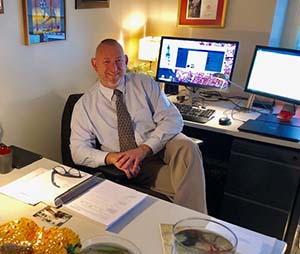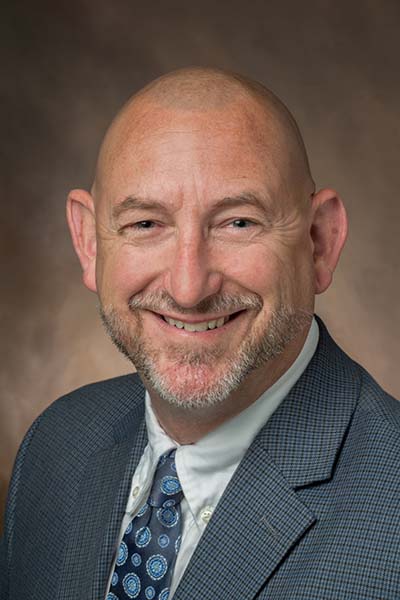
Andy Zeisler has helped Miami become a leader in disability services
By Kristal Humphrey, university news and communications
Andy Zeisler couldn’t have guessed that working as a resident assistant in Havighurst Hall would lead to a 31-year career at Miami University supporting students with disabilities.
The director of the Miller Center for Student Disability Services shares the changes he’s seen that have led to Miami being seen as a leader in the field.
Q: What was your first experience working with students with disabilities?
A: I started as a first-year student at Miami in fall 1984. While here, I was an RA (resident assistant) for three years. I worked in Havighurst my senior year, and it was one of the most accessible halls at the time. There weren’t many. Some students with disabilities were assigned to Havighurst, and I was their RA.
Q: How did you start working in disability services at Miami?
A: At that time, there weren’t degrees in disability services. After graduation, a counselor position in what was then called handicapped services became available at the university. I applied and was offered the position.

Andy Zeisler has helped Miami become a leader in disability services. (Photo by Ricardo Trevino Jr.)
Q: What did you do as a counselor?
A: Students with learning disabilities or ADHD were served out of the Learning Assistance Center. I worked with students with physical disabilities.
Things changed when the Americans with Disabilities Act was signed into law in 1990. It defined disability as a substantial limitation to a major life activity and started defining what those were — walking, talking, hearing, seeing, learning, working, caring for oneself. It broadened the scope of what was considered a disability.
Q: How did your area become the Miller Center for Student Disability Services?
A: In 2018, Scott (Miami ’61) and Susan Miller wanted to give back to the university in a way that would impact students. Since making things accessible was already part of the university’s culture, they gave a $1 million gift earmarked for things beyond compliance at the director’s discretion. It’s being used to provide programming, resources, mini-grants for accessibility action projects, etc.
We have 2000+ students, undergraduate and graduate, registered with the center, which is about 11% of the student body. That is in line with national statistics of college students who identify as having a disability.
We not only provide accommodations but support our students culturally and holistically. The center is getting a name for being a leader in the field because we combine disability services with teaching about disability culture by providing training opportunities, collaborating with disability studies, and partnering with other offices on campus.
Q: Has Miami been used as a model for other schools?
A: More and more. The Association of Higher Education and Disability (AHEAD) is the national organization for best practices in disability services in higher education. At the October Ohio AHEAD conference, the Miller Center team gave four of the nine presentations: our journey of accessibility, preterm consultations, LEAN initiatives in disability services, and how to be a more inclusive campus. People were looking at Miami as a leader, saying they wish they could do what we’re doing.
Preterm consultations involve students who are deaf/hard of hearing or have sight disabilities, their faculty member and a Miller Center staff member meeting to talk about ensuring access to course materials weeks before the class starts. Miller Center staff prepare a summary plan outlining the agreed upon strategies to make sure things are accessible in that classroom on day one.
We spent three years refining the process and will present it this summer to the national AHEAD conference.
Q: What are some changes that have helped with accessibility?
A: Technology has changed everything. Email, instant messaging and texting are available now and have made things easier for people with hearing loss.
There are screen readers for those who are blind or have low vision. We have these capabilities on most of our computers and phones now. The technology allows text to be read aloud, and there are programs that one can use for speech to text also.
These are examples of universal design, things that have evolved to be inclusive, have made things easier for people with disabilities to navigate and access their digital world.

Andy Zeisler (Photo by Scott Kissell)
Q: What was your biggest challenge?
A: Providing access within a structure that was not designed for access.
Over the years, buildings and courses had to be retrofitted. The technological infrastructure of Miami wasn’t originally designed with accessibility in mind. Now we have a partnership with IT services, the AccessMU Center handles accessible technology and there is an accessible technology policy.
It was also a challenge to help people understand that everyone plays a role; it’s not just disability services’ role to ensure accommodations and accessibility. That was the biggest challenge but also the biggest accomplishment. There are other schools that aren’t there.
We have an accessible technology committee comprised of experts around campus in their respective areas who can make sure we’re accessible. Those are huge victories.
Q: What do you enjoy the most?
A: Relationship building with students and staff. It’s all about building relationships and understanding why we do what we do. I’ve enjoyed encouraging people to continue creating a culture of respect. Love and Honor includes everyone.
I’ve also enjoyed my work on the board of the 1809 LGBTQ+ Alumni Association.
I can retire at the end of February and know that when I walk out the door, the university won’t forget about the progress. It will continue. It’s part of our fabric.
Note: The Miami community is invited to Zeisler’s retirement reception 3:30-5 p.m. Wednesday, Feb. 26, in the Shriver Center Dolibois Room B.
